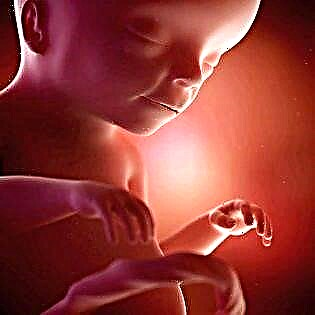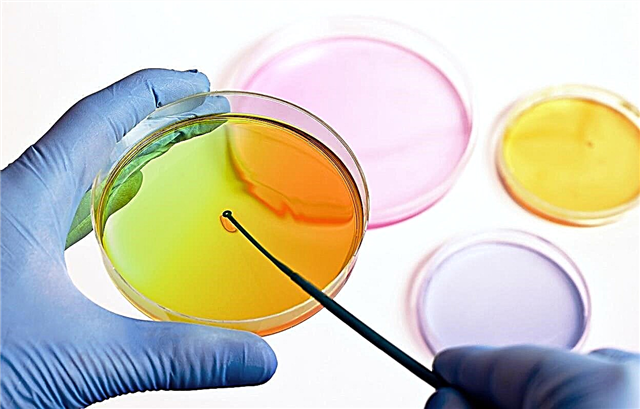
In the midst of the second trimester of pregnancy, quite a lot of transformations take place in the baby's body. The 22nd week of pregnancy is a very important stage in the child's intrauterine life.

Stirring and physical activity
Perhaps the most striking manifestation of the intrauterine development of a baby at this stage is the appearance of active movements in him. Note that the baby moved before - he could bend and unbend the arms, touch himself with his fingers on the umbilical cord, however, the range of movements performed was rather small.
By 21-22 weeks of pregnancy, the number of possible movements in a baby increases several times. There are several reasons for this. First, the child has a well-developed cerebral cortex. Nerve cells at this time actively "cooperate" with each other. This feature makes the baby's behavior more complex. Secondly, the reason for the appearance of active movements in the fetus is also a sufficiently formed musculoskeletal system. The baby's small bones are already quite strong.
Bone density continues to increase with each subsequent day of pregnancy. Calcium is needed to ossify small bones. The lack of calcium in the daily diet of the expectant mother can have an adverse effect on the formation of the entire musculoskeletal system in the fetus, which will negatively affect its intrauterine development.


The relatively small size of the fetus also contributes to the fact that he feels at ease in the uterus. So, the baby is no longer only able to touch his own body with his hands, he can also touch the walls of the uterus. Also, the baby, actively "studying" his water space, can push the uterine walls with his legs.
As a rule, a pregnant woman can already feel such active movements. Very often, women attribute such manifestations to an intestinal disorder or the consequences that have arisen after some unsuitable food eaten. However, every day the movements of the baby in his mother's stomach become more and more powerful.
Some scientists note that the intensity of active movements in the fetus has a number of unique individual characteristics. So, the volume of movements performed may even depend on the nature of the child. A fidgety kid will be more disturbing to his mother than a calm child.

The more the fetus weighs and the smaller the size of the female small pelvis, the, as a rule, the brighter the woman feels the movements of her baby. Doctors believe that at this stage of pregnancy, the baby should be pushed at least 10 times a day. If, for some reason, he pushes much less, then the expectant mother should discuss this fact with her obstetrician-gynecologist.
Sometimes a pregnant woman feels that her baby is kicking too hard. If suddenly the fetus has excessively intense physical activity, this is always a reason to search for the cause of the situation.
Scientists note that the number of fetal movements is influenced by a large number of factors:
- the internal state of a pregnant woman, her psycho-emotional mood;
- the daily diet of the expectant mother;
- region of residence;
- concomitant chronic diseases;
- oxygen intake level.


To normalize fetal activity, doctors recommend that the expectant mother carefully monitor her daily routine. Regular sleep and walks in the fresh air at this time will have a very beneficial effect on the baby's nervous system, and therefore on the amount of movement he makes.
It is important to note that the child has not yet formed a circadian rhythm during this period of his intrauterine life. This means that the baby does not perceive the change of day and night. This leads to the fact that in the evening, when a pregnant woman is about to sleep, her baby decides to "do exercises".
In order to calm the baby, experts recommend the expectant mother to stroke her belly, talk to the baby and even sing him a lullaby.

Feelings in the fetus
The active development of nerve analyzers is necessary, because thanks to them a little man can learn the world around him. It should be noted that the fetus by this time of its intrauterine life is already able to react quite well to various external stimuli.
The most important nerve analyzers that already begin to function in the fetus at 22 weeks of gestation include the following:
- auditory;
- visual;
- gustatory;
- tactile.

Hearing
Scientists note that at this stage of pregnancy, the baby is already able to distinguish between different sounds. He can even recognize the voices of his parents.
For the good development of the children's nervous system, doctors recommend that future dads and mothers be sure to talk with their babies. In this case, you can stroke your stomach, tell your baby fairy tales.
Also, classical music has a beneficial effect on the development of the fetal nervous system. Experts note that you should choose more calm and melodic compositions. Mom and baby should listen to music at a moderate volume. Too loud sounds can only bring the baby discomfort.
Regular "conversations" with the child contribute to the formation of a special favorable psychoemotional contact. In the future, this special bond between mother and child can persist for many years.

Vision
At the 22nd week of pregnancy, the fetus already has eyes that are covered from the outside by the eyelids. In a calm state, when the baby does not make any active movements, it seems that he is sleeping. At this point, the child's brain is truly resting. Even in moments of such calmness, the baby does not stop growing and developing.
Scientists believe that already at 21-22 weeks of gestation, the fetus is able to respond to bright light. Too annoying rays will make the baby turn away from them. Scientific experiments have been carried out, proving that when a bright light is applied to the fetus's face, the baby turns away from it. Excessive sun exposure can stimulate fetal movement.

Taste
It is interesting that the crumb, which weighs less than 500 grams, is already capable of recognizing different tastes. The fetus does this by swallowing amniotic fluid. During the day, he can swallow about 450 ml of liquid. In the future, this liquid enters his body, a number of components are absorbed, while most of it is excreted through the kidneys. This developmental feature helps the baby's urinary system to fully develop.
During swallowing, the child's breathing apparatus also improves. The fact is that the baby makes swallowing movements with the direct participation of the respiratory muscles. Such specific preparation is necessary for the baby for further independent life. Sufficiently developed respiratory muscles are necessary for taking the first breath and for spontaneous breathing.
Swallowing amniotic fluid, the baby can taste it. The child may like him or not. The taste of amniotic fluid is greatly influenced by the food that a pregnant woman eats.... The amniotic fluid can taste differently: it is salty one day, and sweeter or even bitter the next.


Touch
The kid may already define the boundaries of some objects. As a rule, the sense of touch in the fetus at this stage of its intrauterine life is manifested by the fact that the baby begins to touch its own umbilical cord, touch the face.
This study of the world is actively manifested in twins. They begin to study each other, they can hold hands. Babies make such movements unconsciously. Through such communication, the further development of their nervous system and analyzers occurs.
Appearance
The child still looks pretty funny. He no longer resembles a tadpole or an alien, but does not yet look like an ordinary person.
The proportions of the child's body by the 22nd week of pregnancy are changing somewhat. The arms and legs of the fetus are already stretched out, while the head does not look overly huge in relation to the whole body.
The kid still looks very small. The amount of fatty tissue under the skin is still insignificant. Every day, the brown adipose tissue in the child's body will increase - this is necessary so that the baby can live independently in the external environment.


The subcutaneous fat is necessary for the child for heat regulation. An insufficient amount of fat can contribute to severe hypothermia after the baby is born.
Your baby's skin looks wrinkled. Almost the entire surface of the body is covered with small vellus hairs. The color of the skin of the fetus is still rather pink, but gradually begins to fade. This is due to the fact that every day more and more original lubricant appears on the surface of the skin. It is formed by mixing the secretion of the sweat and sebaceous glands in the skin with desquamated epithelial cells.
Body parameters
In order to determine the basic dimensions of a baby's body, doctors use a special diagnostic method called fetometry. At its core, this is an ultrasound examination that allows you to determine the size of important internal organs in a baby.

Each week of pregnancy is characterized by its own norms of the investigated sizes. Important clinical signs in a fetus at 22 weeks gestation are shown in the table below.
Another important criterion for assessing the intrauterine development of the fetus is the calculation of the heart rate (HR). At 22 weeks of pregnancy, it can be calculated not only when performing an ultrasound examination, but also during a clinical examination by a doctor using a conventional obstetric stethoscope. Normal fetal heart rates at 22 weeks gestation are 140–160 beats per minute.

Location in the uterus
The baby can be located in the mother's womb in different ways. One of the most advantageous locations is the cephalic presentation. In this case, the baby's head is directed towards the entrance to the small pelvis. With cephalic presentation, natural childbirth, as a rule, proceeds favorably. The risk of developing birth injuries is significantly lower than with other types of presentation.
A less favorable option for fetal presentation is pelvic. In this case, not the baby's head, but his pelvis is turned towards the birth canal. This "reverse" arrangement of the baby significantly complicates the process of natural independent childbirth. With breech presentation, doctors most often resort to a surgical method of obstetric aid and perform a cesarean section.
A less favorable variant of the location of the fetus in the uterus can be dangerous by the development of a number of pathological conditions. So, if, while carrying a baby, a woman noticed a leakage of amniotic fluid, or she developed severe pain in the abdomen, she should immediately seek medical help.

For how the fetus develops at 22 weeks of gestation, see the next video.



